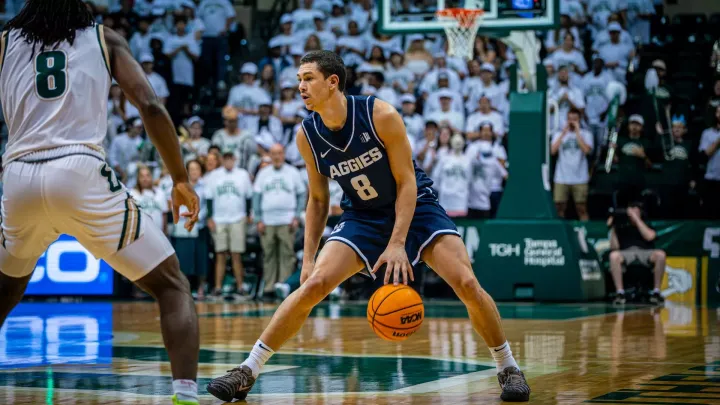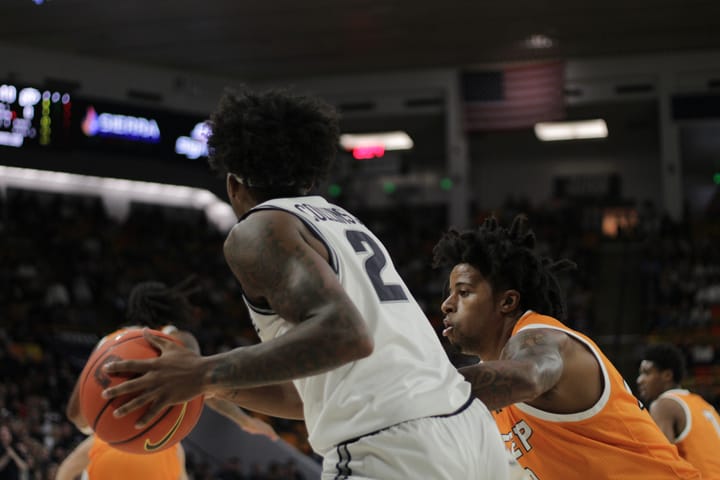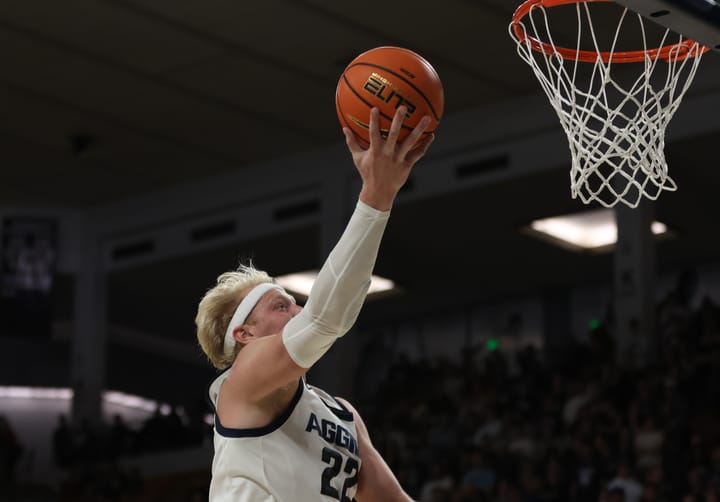Inside The NIL Push That Kept Utah State's Core (And Coach) In Logan
Inside the NIL fundraising flurry that helped Utah State retain the core of its basketball roster, and the future role of the Blue A Collective in a post-House settlement world. Free for all to read:
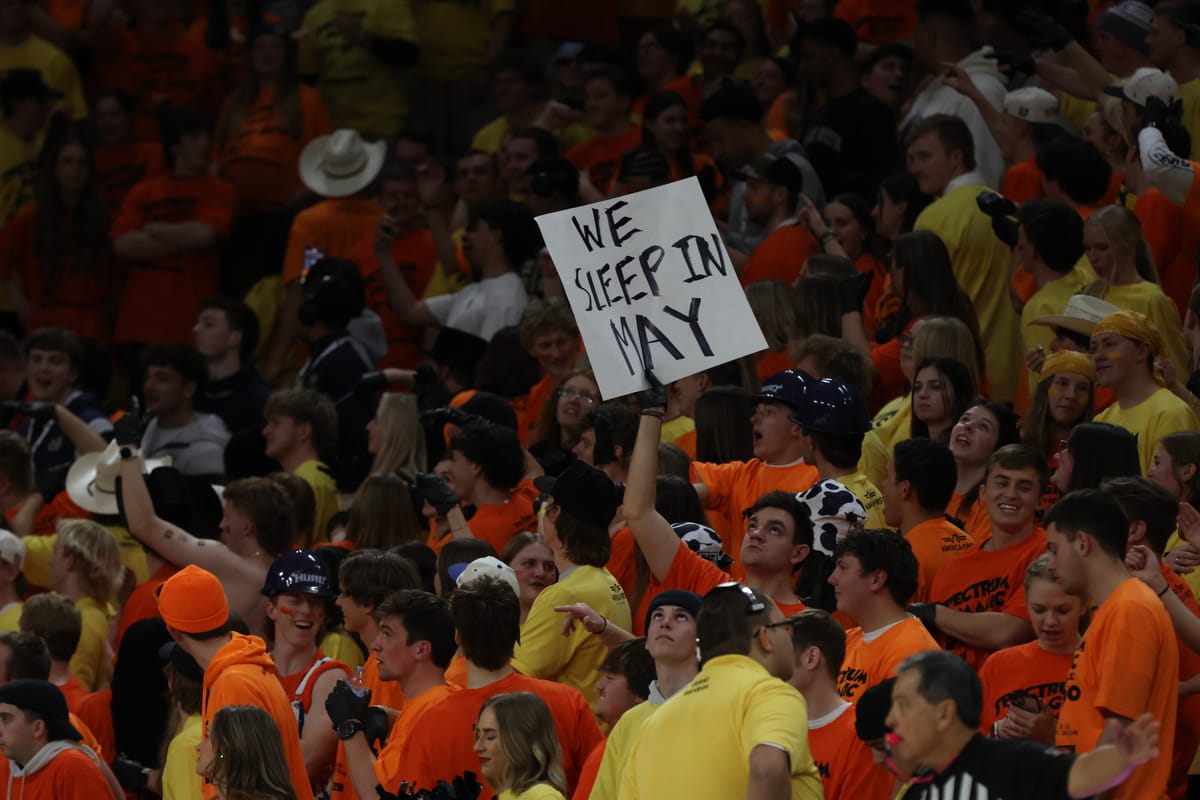
Utah State's first steps into the world of name, image and likeness rights were small and uncertain, even perfunctory. It was not alone in its trepidation immediately following the landmark June 2021 Supreme Court ruling on NCAA v. Alston and the unprecedented upheaval in collegiate athletics it entailed. With little in the way of formalized guidance from the NCAA, universities were left to fend for themselves: Their involvement, or lack thereof, depended on their own tolerance for risk and on the appetites of their respective fan and booster bases.
Some, like BYU, Florida, Miami, Missouri, Oregon, South Carolina, Tennessee and Texas A&M, pushed the landscape toward its current configuration as early adopters of NIL collectives – part clearinghouse to connect athletes with interested businesses and part donor fund to be shared as the collectives saw fit. Others, Utah State included, regarded the increasingly choppy waters with more apprehension. In those early stages, the Aggies took NIL at its initial definition, as an opportunity for marketable athletes to profit from (usually local) business sponsorships. Justin Bean signed an endorsement deal with Taco Time. Logan Bonner connected with Deseret First Credit Union. Other athletes began to launch personal brands, hold autograph sessions, and host offseason skill camps for local youngsters. Utah State expanded that platform in 2022 when it came to an agreement with Opendorse, an NIL marketplace connecting athletes and would-be advertisers.
It would take another year, however, for Utah State to officially venture into the world of NIL collectives. Gary Andersen and Eric Laub co-founded the Blue A Collective in the spring of 2023, and formally partnered with Utah State athletics in early September of the same year, roughly one month after athletic director Diana Sabau's arrival in Logan. Even then, Utah State had merely entered the game, and still lagged well behind during a time that saw the proliferation and professionalization of NIL collectives across college athletics. The Blue A Collective drew mentions from Aggie coaches and advertisements from the university, but it was a two-man operation spawned chiefly because someone had to do it – Laub has his hands full with responsibilities at Cache Valley Electric, and Andersen didn't exactly aspire to NIL kingpin status.
The latter's departure for a consulting role at BYU in March of 2024 came as something of a surprise, but the split worked out nicely for both parties: Andersen again returned to the gridiron, as he has several times before after brief exits from the coaching world, and the Blue A Collective found a welcome opportunity to bolster its operations with new leadership. Nick Eliason, a Cache Valley native and partner with Orem-based investment firm Sandlot Partners, joined the Blue A Collective's board of directors to spearhead fundraising efforts in early March. Over the past year, that board has expanded to include six members, all working on a pro bono basis.
That growth came just a bit too late to stave off the decimation of Utah State's football roster, which lost seven full- or part-time starters and quite a few more contributors to the transfer portal after a disappointing 2023 season, but couldn't have arrived at a much better time for Jerrod Calhoun and the newly hired basketball coaching staff. Calhoun, who was integral in the development of Youngstown State's Penguin Collective before he succeeded Danny Sprinkle last April, had a Mountain West championship-winning roster to retain, and began his own fundraising push from the moment he stepped on campus.
The Aggies couldn't keep pace in the sweepstakes for star forward Great Osobor, who entertained some of the deepest-pocketed suitors in college basketball and eventually signed an NIL deal worth $2 million to follow Sprinkle to Washington, but they fared infinitely better than they had the year prior. Mason Falslev, Isaac Johnson, Ian Martinez and Karson Templin all opted to stay in Logan, while only Osobor and Josh Uduje slipped away from the primary list of retention targets; the latter departing for playing time rather than financial incentives. It was proof of concept not only for Calhoun and Co. as recruiters, but for the Blue A Collective, which, like most NIL collectives at the mid-major/G5 level, is geared more toward player retention than it is acquisition.
“While we don’t typically share specific figures, I can tell you that the balance between retention and acquisition really varies year to year,” Dalton Forsythe, a former Utah State offensive lineman who now serves on the Blue A Collective’s board, told The Aggship. “As a program, our emphasis has largely been on retention rather than acquisition. We’re not in the business of chasing high-profile transfers with massive offers – we simply don’t have the resources to compete in that space. Instead, our model is built around identifying talented student-athletes who are a good fit for our culture, helping them grow and thrive, and then doing everything we can to keep them here.
“That’s where the challenge lies. As these athletes develop and start getting national attention, the cost to retain them naturally increases. So while acquisition isn’t a major line item for us, retention has become more and more critical – and more expensive – every year. As you can probably infer, we end up spending significantly more on retention than on acquisition.”
Utah State had little time to celebrate its success on that front, its seven-man transfer portal class, or the highest-rated recruiting class in program history it signed in November. Stocking the NIL coffers is a year-round process, and Calhoun, Eliason and Sabau held events throughout the offseason and into the 2024-25 campaign accordingly. Some were designed to rally active donors, while others were informational introductions for fans unaware of the Blue A Collective or uneasy about this new world Utah State finds itself in.
"We're just trying to educate people (on NIL),” Calhoun said. “It's changed so fast that a lot of people didn't know what it was at first. It's just consistent giving, it's like anything else. We all give to something. It's just consistent giving for the team you love, and we have so many Aggie fans who love these players and the team that the more we can talk about it, the better, because I think it gets them on board."
One event in particular, held just days before Utah State's season-ending NCAA tournament loss to UCLA, may well have altered the long-term trajectory of the program. That's a troubling amount of weight for one evening to bear, though it was quite the evening. At an NIL Open House event on March 17, with Calhoun and newly hired head football coach Bronco Mendenhall taking center stage, Utah State and the Blue A Collective began a week-long fundraising barrage that brought in more than $1.5 million – and more money, on the first night alone, than Calhoun had at his disposal for the entire 2024-25 roster. It didn't launch Utah State into the now notorious $10 million (and beyond) club, but the push was successful beyond even the loftiest internal expectations.
It was also absolutely essential to Utah State's efforts in keeping Calhoun at the helm during the week that followed, which saw him cast as a leading candidate for the vacant head coaching job at West Virginia and landed, on March 25, with a contract addendum that made him the second-highest paid coach in the Mountain West.
"One thing that has changed is the NIL," Calhoun said. "You're looking at Big Ten teams now spending upwards of $9, $10 million. You're looking at the SEC spending between $5, $8 and $10 million for rosters. If Diana was not the athletic director, and (if not for) our staff and Nick (Eliason) and Eric Laub, and the support we have, we wouldn't make those jumps and those gains in NIL... We had an event the other night, we raised $1 million in one night. Last year, we didn't have that. We didn't have that for the entire roster. I think that shows the commitment from our university and the commitment from Cache Valley."
And in this year's frenzied transfer portal market, supercharged by revenue sharing at the high-major level and anxiety about how the impending House settlement may impact NIL spending, Utah State needed every last cent to fortify its walls against poachers backed by more money than they knew what to do with. That work started, naturally, with Cache Valley's own Mason Falslev. An early favorite for the 2025-26 Mountain West Player of the Year race alongside San Diego State's Magoon Gwath, Falslev had already been inundated with back-channel promises of massive paychecks for months by the time the transfer portal opened. As valuable as he may have been as a transfer, however, Falslev was that much more important to his hometown school.
“We got Mason Falslev back,” Calhoun said. “To me, he and Magoon and Miles Byrd are the three best players in the league who are coming back. It's not to say they'll be the best players in the league next season, they have to do a lot of work, and Mason will do it, but let's call it like it is. They're the three most established guys in the league, they've had an unbelievable two seasons, Magoon had a great year and Byrd has been good, but I wouldn't trade Falslev for any of them. I think Falslev can shoot the three, drive to the basket, and he embodies what Cache Valley is.
“Part of my thought process was him in the back of my mind, and I was very honest with him throughout the whole thing of coming back here and trying to build this for the next three or four years to make a run. If we can't keep our best player, then we're not really financially all the way in this deal. Guys like Jim Laub and Eric Laub, Nick Eliason, Kevin White and Kent Alder, all these people who have stepped up, Jonathan Bullen here recently made a major gift. They're what make this place what it is, and I think you have to have a superstar. Mason is."
Of course, it certainly helped that the rising redshirt junior had every intention to return for his fourth season with the Aggies, so long as he knew he could rely on the same commitment from his coach and school. The money did not need to be equal (and it wasn't), but as Calhoun put it during the season, Utah State had to show its incumbents that they're appreciated – and as in any labor market, that has to include appropriate compensation.
"In all honesty, even during the season, there are tons of agents trying to get a hold of you, and they say this and that," Falslev said. "When the portal opened up, I never got in the portal so I didn't have to deal with a million phone calls, but there were definitely other ways that things happened. But, it wasn't too crazy because I knew I wanted to stay here. I just wanted to know what the situation would be and how we would make it work. It was stressful for a little bit, just because of how the portal is. You get all these things thrown at you and you're like, 'Oh my gosh, is this real?' At the end of the day, I wanted to be here and I really like playing for Calhoun and his staff. It was a pretty easy decision. I signed the papers like 30 minutes ago that I'm coming back. I can't wait, it's going to be great."
With Falslev's signature secured, Calhoun and Co. could begin constructing a roster around him, again starting with those already on campus. Joined later on by a strong five-man transfer class, Drake Allen, Tucker Anderson, Jordy Barnes and Templin followed Falslev's lead and came to their respective agreements to stick around. That's not a figure of speech in this case, either: The Blue A Collective makes a point of operating by the book, insofar as there is a book to operate by within an industry sorely lacking regulation or oversight from the NCAA.
“On the retention front especially, our reputation for fulfilling obligations has made a huge difference,” Forsythe told The Aggship. “When we're in discussions with potential transfers or high school recruits, many of them have agents, attorneys, parents, or coaches carefully reviewing our contracts. And our response is simple – just Google us. You won’t find a single instance of non-payment or a dispute involving our collective. That level of trust and follow-through instills real confidence.
“We also pride ourselves on professionalism. Every NIL agreement we offer is formalized with a contract, and we execute those agreements as quickly as legally allowable. For the athletes we’re trying to retain, that reliability matters just as much. They see that community support is growing, that Cache Valley is not only a great place to compete but also a place where they’re genuinely valued. Plus, having leadership like myself, Eric Laub, and Nicholas Eliason here locally, regularly interacting with the athletes – it all contributes to a sense of stability and trust that’s hard to replicate.
"One of the biggest misconceptions is that NIL is only for superstar athletes or that it’s some kind of cash grab. At a place like Utah State, that's simply not the case. For example, the football scholarship stipends haven’t meaningfully increased in nearly 20 years. So NIL isn’t about making athletes rich – it’s about helping them make it. We’re giving student-athletes a chance to cover basic needs, support their families, and stay focused on school and sports. And this support often goes to athletes across the board, not just the top names."
Its status as a 501(c)(3) non-profit organization, which The Aggship has confirmed with publicly available records provided by the IRS, is a rarity among NIL collectives and has a major role to play in ensuring said compliance and informing the obligations of signed athletes.
“That designation means we are recognized by the IRS as a charitable organization, which allows us to accept tax-deductible donations,” Forsythe explained. “It also means we operate under strict compliance rules, including transparency, accountability, and a clear focus on public benefit... Through our model, student-athletes engage in meaningful service, such as youth outreach, education, and charitable projects, allowing them to use their platform for good while still receiving NIL opportunities. It’s a win-win that supports personal development, community impact, and compliance with NCAA and IRS guidelines.”
Those guidelines, at least from the NCAA, are expected to expand upon approval for the House settlement. Capped revenue sharing, a key component of the settlement, is slated to go into effect on July 1 (again pending judge approval), but it won't be the only major change brought about by the extensive antitrust case. That revenue-sharing cap wouldn't be much good without oversight to dissuade big-spending programs from double-dipping with NIL, as they did this spring, and the NCAA hopes that an official NIL clearinghouse (NIL Go) will ensure all deals are legitimate by requiring athletes to report all third-party NIL deals exceeding $600 in total value.
Whether that proposal will actually come to fruition is still something of an open question, given that the clearinghouse also intends to confirm that deals are commensurate with fair market value, which brings about a whole new set of concerns.
No matter the form it ultimately takes, the legislative reconstruction of college athletics likely won't drastically alter the strategies of Utah State and the Blue A Collective. Even with the most optimistic estimates for the new Pac-12's forthcoming television contract, the former will not be near the annual $20.3 million revenue-sharing cap that has been projected. That means it will still rely on the latter, which expects to be compliant with increased oversight from day one, to remain competitive.
“The House settlement is reshaping the landscape, and there’s still a lot of uncertainty about how everything will play out,” Forsythe said. “But here's what we do know. One of the key components of the settlement is the cap on athletic department expenditures, especially as it relates to revenue sharing with student-athletes. For a school like Utah State, which likely won’t come close to hitting that cap, we don’t anticipate major changes to Blue A Collective’s role in the short term.
“That said, the settlement does introduce an additional layer of oversight from universities and a greater emphasis on transparency, both internally and to the public. We welcome that. As a 501(c)(3), we’re already structured for accountability, and we see this as an opportunity to continue building trust with our supporters and the broader community.”
And practically, it means the work of NIL outreach and fundraising at Utah State will continue apace, as the material reality of big-time college athletics now dictates. The Aggies could not have kept their core of talent together without the local support they've garnered over the past year, and their focus now is on sustaining and furthering that support, not just in preparation for next March, but for the continued success of every team that represents both Utah State and Cache Valley.
“Some people think NIL is just a temporary phase or that it’s going to get shut down, but we don’t see it that way,” Forsythe said. “The reality is, the NCAA and universities have capitalized on players’ names, images, and likenesses for decades without those players receiving a share. NIL is simply the market correcting itself.
“Now, it’s up to the Cache Valley community and our USU alumni to decide what kind of product they want to see on the field or court – and to give the collective the resources to make that happen. It’s not blackmail or extortion; it’s basic supply and demand. High-demand players require meaningful backing. That said, we’ve been fortunate to work with a lot of athletes who’ve gone out of their way to stay Aggies, even when it meant leaving money on the table. That says a lot about our program, and the kind of support system we’re building.”
"What Kevin (White), Nick (Eliason), Jim Laub and Kent Alder have done, it's why you stay," Calhoun said. "It's why you feel special, why you work so hard. And it's not just for those guys, but for the student body and the fans who buy season tickets and pay those prices. Everybody sacrifices for the Aggies."
